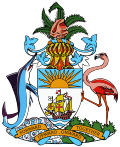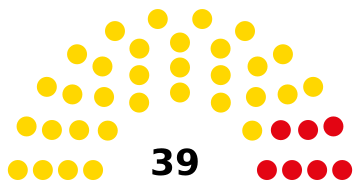Parliament of the Bahamas facts for kids
Quick facts for kids Parliament of The Bahamas |
|
|---|---|
| 14th Bahamian Parliament | |
 |
|
| Type | |
| Type | |
| Houses | Senate House of Assembly |
| History | |
| Founded | 4 March 1729 |
| Leadership | |
|
Charles III
Since 8 September 2022 |
|
|
Cynthia A. Pratt
Since 1 September 2023 |
|
|
President of the Senate
|
Lashell Adderley, PLP
Since 6 October 2021 |
|
Speaker
|
Patricia Deveaux, PLP
Since 6 October 2021 |
|
Philip Davis, PLP
Since 17 September 2021 |
|
|
Leader of the Opposition
|
Michael Pintard, FNM
Since 27 November 2021 |
| Structure | |
| Seats | Senate: 16 seats House: 39 seats |
|
Senate's political groups
|
HM Government
|
|
House's political groups
|
HM Government
|
| Elections | |
|
House's voting system
|
First-past-the-post |
|
House's last election
|
16 September 2021 |
| Meeting place | |
 |
|
| Bahamian Parliament, Nassau, The Bahamas | |
The Parliament of The Bahamas is the main law-making body for the country. It is bicameral, meaning it has two main parts or "houses." These parts are the Senate and the House of Assembly. The Parliament also includes the King (represented by the Governor-General).
The Parliament meets in the Bahamian Parliament Building in Nassau, the capital city. Its structure and how it works are based on the Westminster system. This system is a way of running government, like in the United Kingdom, where the Parliament makes laws and the government is chosen from the members of Parliament.
Contents
A Look Back: History of the Parliament
Early Days and British Rule
Long ago, the Bahamas were home to the Lucayan people, who were part of the Taino group. In 1492, Christopher Columbus arrived, marking Europe's first contact with the New World. Sadly, many of the native Lucayans were taken away from the islands.
The islands were mostly empty from 1513 until 1648. That's when English settlers from Bermuda came to live on the island of Eleuthera.
In 1670, King Charles II gave control of the islands to a group of English owners called "lords proprietors." They managed the islands, collected taxes, and chose leaders. The Bahamas later became a British colony in 1718. This happened when the British government took over to stop pirates who were causing trouble in the area.
The first Parliament, called the General Assembly, started in 1729. The very first elections took place in September of that year. On September 29, 1729, twenty-four members from New Providence, Eleuthera, and Harbour Island met to form this assembly.
Becoming Independent
The Bahamas' law-making body has had two parts since it began in 1729. At first, the Governor's Council handled both running the country and making laws. In 1841, a leader named Governor Francis Cockburn split this council into two groups. One group, the Executive Council, managed daily government tasks. The other, the Legislative Council, focused on making laws.
The Legislative Council later became the Senate in 1964. The House of Assembly became the main law-making body. Even so, the Senate is still known as the "upper house" and the House of Assembly as the "lower house."
Bahamians gained the right to govern themselves in 1964. Then, on July 10, 1973, it became a fully independent country. It remained part of the Commonwealth of Nations, with Queen Elizabeth II as its Queen at that time. The Parliament, as it works today, was set up by the country's Constitution when The Bahamas became independent from the United Kingdom.
The House of Assembly: Making Laws for Everyone
The House of Assembly is the "lower chamber" of Parliament. It has 39 members, who are called Members of Parliament. These members are chosen by voters from different areas (called constituencies) for five-year terms.
Like in the Westminster system, the government can decide to hold new elections at any time. The House of Assembly is where most of the important laws are made. The Prime Minister is the leader of the political party that wins the most seats in the House of Assembly.
How Members are Chosen
The members of the House of Assembly are elected by the people. Each member represents a specific area of the country.
Latest Election Results
The most recent general election was held on September 16, 2021. In this election, the Progressive Liberal Party won the most seats.
The Senate: A Second Look at Laws
The Senate is the "upper house" of Parliament. It has 16 members who are chosen by the Governor-General.
Who are the Senators?
Nine senators are chosen based on the advice of the Prime Minister. Four are chosen based on the advice of the Leader of the Opposition. The remaining three are chosen by the Prime Minister after talking with the Leader of the Opposition.
Sharon Wilson made history by being the first woman re-elected as President of the Senate. She served from 2002 to 2007 and again from 2012 to 2017. She was followed by Katherine Forbes-Smith, then Mildred Hall-Watson, and currently, Lashell Adderley.
How the Senate Works with Laws
The Senate can approve bills (proposed laws) that come from the House of Assembly. It can also suggest changes to a bill. If the Senate makes changes, the House of Assembly must approve them.
The Senate can even reject a bill. However, if the House of Assembly passes the same bill two times in a row, and the Senate rejects it both times, the House can send the bill directly to the Governor-General for approval without the Senate's agreement.
For bills about money, if the Senate doesn't approve them within one month, the bill can still go to the Governor-General to become law.
What Does Parliament Do?

The country's Constitution (its main rulebook) gives Parliament the power to make laws for the peace, order, and good government of The Bahamas.
Parliament also has other important jobs:
- It decides on the special rights, protections, powers, and rules for both the Senate and the House of Assembly.
- It can change parts of the Constitution.
- It decides who works for the Governor-General.
- It decides how many judges there will be in the Supreme Court and Court of Appeal.
- It approves the government's budget, which is its plan for spending money.
Parliament also checks how the government spends money through a special committee. It is also the place where important national issues and government plans are discussed.
How a Bill Becomes a Law
Most new laws either create something new or change old laws. The Constitution says Parliament makes laws by passing a "bill" (a proposed law). Usually, a government minister suggests a new bill. But any member of Parliament can suggest one.
For a bill to become a law, both the House of Assembly and the Senate must agree to it. Then, the Governor-General must officially approve it.
There are different types of bills, like those for the public, for money matters, or for specific individuals or groups.
Steps to Becoming a Law
A bill goes through several steps in each part of Parliament:
- First Reading: The bill is formally introduced. Its title is read, and it's printed for everyone to see.
- Second Reading: Members discuss the main idea of the bill.
- Committee Stage: The whole House looks at the bill very closely, section by section, and suggests changes.
- Third Reading: This is the final vote on the bill. If it passes, it moves to the Senate for their review.
Parts of a Bill
Each bill has different parts. These parts explain what the bill is about, what it's called, and what rules it wants to create. For example, the "long title" describes the bill's purpose, and the "short title" is its easy-to-remember name. There's also an "interpretation clause" that defines important words used in the bill. The main body of the bill contains all the new rules and measures.
Important People in Parliament
- List of current members of the House of Assembly of the Bahamas
See also
 In Spanish: Parlamento de Bahamas para niños
In Spanish: Parlamento de Bahamas para niños
- List of presidents of the Senate of the Bahamas
- List of speakers of the House of Assembly of the Bahamas
- List of legislatures by country


